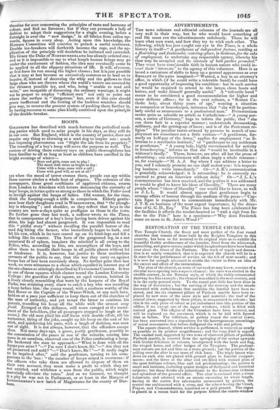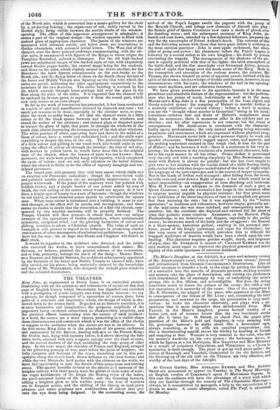RESTORATION OF THE TEMPLE CHURCH.
THE Temple Church, the finest and most perfect of the four round churches that remain of those built by the Knights Templars in this
country, has been so far restored to its original state as to exhibit the beautiful Gothic architecture of the interior, freed from the whitewash, pannelling, and grave-stones, under which its splendours have been buried
ever since the times of the Puritans. The work of repair and decora- tion is so nearly completed, that it is expected the church will be in a fit state for the performance of service on the 6th of next month ; and it is now far enough advanced to enable the visiter to form an idea of the extent and effect of the restorations.
The plan of the chard; as some of our readers may know, consists of a circular nave opening into a square chancel: the nave was erected in the twelfth century, in the Norman style, of which the richly-ornamented doorway is a fine example ; the chancel was added in the next century, and is in the early pointed style. To the round part little has been done in the way of decoration ; but the carving of the doorway and the arcade decorated with corbel-heads that encircles the interior have been re- stored, and the six clustered pillars of Purbeck marble have been re- placed by new ones of the same style and material : the roof of the central tower, supported by these pillars, is ornamented in colours ; but this is the only piece of colour as yet introduced into this portion of the edifice, if we except one of the upper windows, a hich is filled with stained glass. The effigies of the Crusaders have been restored, and will be replaced on the pavement, which is to be laid with figured tiles as before. The triforium, or gallery round the central tower, has been converted into a depository for the heterogeneous assemblage of mural monuments that before disfigured the walls and pillars.
The square chancel, where service is performed, is restored as nearly as possible to its pristine magnificence ; and the coup &cell is superb. The vaulted roof, supported by two rows of clustered pillars of polished Purbeck marble, is covered from the springing of the arches upwards with Gothic foliations in colours, interspersed with the lamb and flag, the winged horse, and other badges of the Templars. The predomi- nant colours are red and blue on a stone ground ; but the portion of the ceiling over the altar is one mass of rich hues. The triple lancet win- dows on each side are glazed with ground glass in fanciful compart- ments; and the three at the altar end are filled with stained glass of the most brilliant colours, blue and red predominating : the pattern is small and intricate, including quaint designs of Scriptural and historical subjects ; but these details are subordinate to the harmonious richness and splendour of the general effect. The altar is enclosed with a stone balustrade, and adorned with an arcade extending its whole length, having in the centre five tabernacles surmounted by gablets, the central one emblazoned with a cross, and the others having the Creed, Prayer, and Commandments, inscribed on a gold ground. The organ is placed in a recess built for the purpose behind the centre-window of the North side, which is converted into a music-gallery for the choir by a projecting balcony ; the organ-case of oak, richly carved in the Gothic style, being visible between the marble shafts of the window. opening. The effect of this ingenious arrangement is admirable; it seems a part of the original design : the window opposite is filled with stained glass of appropriate character. The jambs of the windows are decorated with coloured scrolls and below them are inscriptions in Gothic characters, with coloured initial letters. The West end of the chancel, over the three pointed archways communicating with the eir- War nave, is ornamented with figures of the Kings in whose reigns the Templars flourished, painted in distemper. For the old high-backed pews are substituted ranges of low-backed seats of oak, with exquisitely carved Gothic poppy-heads; the central range being for the students, and those on the sides, which slightly ascend one above another, for the Benchers : the lamb figures conspicuously on the seat-backs on the North side, and the flying horse on those on the South ; these devices of the Inner and Middle Temple also figuring on the tiles with which the aisles are paved, indicating the sides appropriated respectively to the members of the two Societies. The entire building is warmed by hot air, which ascends through brass gratings laid over the pipes in the floor along the sides of the aisles. It is expected that the chancel will be enclosed by bronze gates, to separate it from the round part, which now only serves as an ante-chapel.
So far as the work of restoration has proceeded, it has been conducted in a spirit of zeal and munificence directed by research and taste ; but much yet remains to be done, especially in the circular nave, to com- plete the work so nobly begun. All that the chancel wants is a little colour to fill the blank spaces between and below the windows, and round the arches of the entrance ; and stained glass or diapered panes to temper the glare of light, that pours in through the windows of the south side, almost destroying the transparency of the rich altar-windows. The white patches of stone, appearing here and there in the midst of a blaze of colour, have a crude and unfinished look ; and the stalls want varnishing to deepen the tone of the oak. The judicious introduction of a little colour and gilding in the wood-work also would assist in car- rying the effect of colour all through the interior : the tiles of red clay, with devices in yellow burnt in, would have done this in the original state of the church, when the luxury of seats was not known : then, moreover, the walls were probably hung with tapestry, which completed the cycle of colour; now we can only calculate on the ladies' dresses, when the church is filled, to do the office of tapestry hangings and tes- selated pavement. The round part still presents that cold bare aspect which chills ore on entering our Protestant cathedrals ; though the stone-tinted walls and polished marble columns are an acceptable improvement on the pauper whitewash. If the joints of the masonry were but pointed with reddish brown, and a simple border of one colour added by way of finish, the rich ceiling of the centre tower would not appear, as it now does, a bright spot of beauty in a waste of bareness: though the windows be not tinted, at least diamond panes should be substituted for square ones. When once colour is introduced into a building, it must be car- ried through, or the effect will he patchy and incongruous ; and there seems no reason to doubt that the restoration of a fine old church, com- menced by two wealthy societies, will be properly finished. The Temple Church will then present—it almost does now—an unique example of the splendours of Gothic decoration, where architectural symmetry, sculptural relief, and the glowing harmonies of colour and gilding, combine to adorn a Christian church. The value of such an example is still greater in regard to its influence in promoting similar restorations of other monuments of ecclesiastical architecture. Lawyers have led the way ; let us hope that Deans and Chapters will follow in their track.
It would be injustice to the architect who directed, and the artists who executed the works, to leave unmentioned their names: Mr. SAVAGE, we believe, planned the general scheme of the restoration, and to him, primarily, belongs the merit of the design : Messrs. Duct- /um BURTON and SIDNEY SMIRKE, the architects subsequently appointed by the Societies of the Inner and Middle Temple to succeed him, have ably carried out his plans ; being materially assisted by the knowledge and taste of Mr. WILLExErrr, who designed the stained glass windows and the coloured decorations.



























 Previous page
Previous page